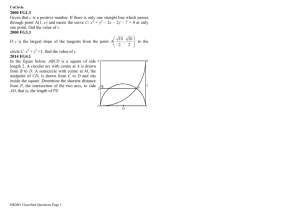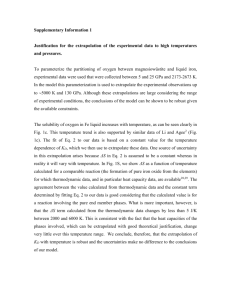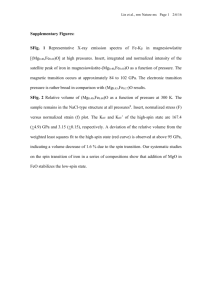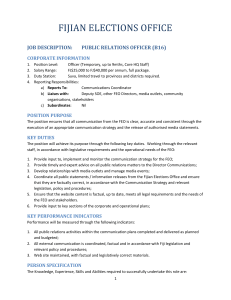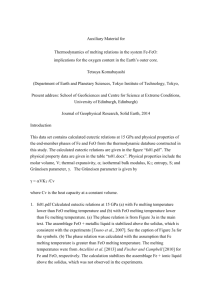MAGNETIC COLLAPSE AND THE BEHAVIOR OF TRANSITION METAL
advertisement
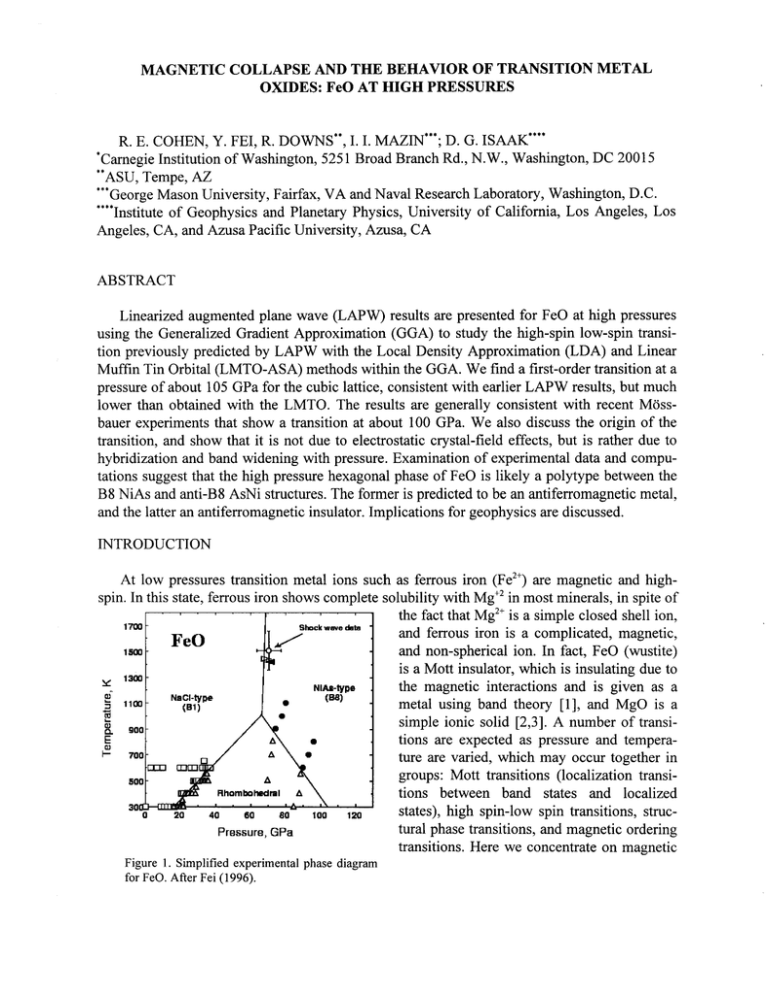
MAGNETIC COLLAPSE AND THE BEHAVIOR OF TRANSITION METAL
OXIDES: FeO AT HIGH PRESSURES
R. E. COHEN, Y. FEI, R. DOWNS **,1. 1. MAZIN *** ; D. G. ISAAK ****
'Carnegie Institution of Washington, 5251 Broad Branch Rd., N.W., Washington, DC 20015
"ASU, Tempe, AZ
"'George Mason University, Fairfax, VA and Naval Research Laboratory, Washington, D.C.
Institute of Geophysics and Planetary Physics, University of California, Los Angeles, Los
Angeles, CA, and Azusa Pacific University, Azusa, CA
ABSTRACT
Linearized augmented plane wave (LAPW) results are presented for FeO at high pressures
using the Generalized Gradient Approximation (GGA) to study the high-spin low-spin transition previously predicted by LAPW with the Local Density Approximation (LDA) and Linear
Muffin Tin Orbital (LMTO-ASA) methods within the GGA. We find a first-order transition at a
pressure of about 105 GPa for the cubic lattice, consistent with earlier LAPW results, but much
lower than obtained with the LMTO. The results are generally consistent with recent Mossbauer experiments that show a transition at about 100 GPa. We also discuss the origin of the
transition, and show that it is not due to electrostatic crystal-field effects, but is rather due to
hybridization and band widening with pressure. Examination of experimental data and computations suggest that the high pressure hexagonal phase of FeO is likely a polytype between the
B8 NiAs and anti-B8 AsNi structures. The former is predicted to be an antiferromagnetic metal,
and the latter an antiferromagnetic insulator. Implications for geophysics are discussed.
INTRODUCTION
At low pressures transition metal ions such as ferrous iron (Fe2+)are magnetic and high-
spin. In this state, ferrous iron shows complete solubilitywith Mg+2 in most minerals, in spite of
1700
Shock wave data
FeO
1500
~
1300
Q)
:s
1100
2S..
E
Q)
900
NIAI-type
(B8)
NaCI-type
(B1)
1iJ
....
I-
/
700
a:IJ
b.
500
Rhombohedral
30
a
20
40
60
Pressure,
80
100
120
GPa
Figure 1. Simplified experimental phase diagram
for FeO. After Fei (1996).
the fact that Mg2+is a simple closed shell ion,
and ferrous iron is a complicated, magnetic,
and non-spherical ion. In fact, FeO (wustite)
is a Mott insulator, which is insulating due to
the magnetic interactions and is given as a
metal using band theory [1], and MgO is a
simple ionic solid [2,3]. A number of transitions are expected as pressure and temperature are varied, which may occur together in
groups: Mott transitions (localization transitions between band states and localized
states), high spin-low spin transitions, structural phase transitions, and magnetic ordering
transitions. Here we concentrate on magnetic
high-spin low-spin transitions, and
,
-0.6
structural transitions in FeO.
A simplified experimental
-0.7
phase diagram for FeO is shown
-0.8
in fig. 1. With increasing pressure
;..
there is a transition from cubic
..
-0.9
rocksalt to a strained rhombohe4.
,
dral structure, and at higher pres-1.0
'~
..
sures a NiAs-type (B8) phase is
.. .
-1.1
..4...
observed.
.......
Magnetic collapse was pre,
,
-1.2
I
160 170
130
UO
150
90
100
110 1:!1
70
80
dicted at high pressures using
first-principles
computational
V (bohr'lFeO)
methods [4,5]. Recently, experiFigure 2, Energy versus volume for AFM FeO computed
mental evidence was presented for
using LAPW and GGA PBE96. A dimple is evident in the
total energies, indicating a first order phase transition. The
magnetic collapse at about 100
dotted lines are Birch equation of state fits to the low pressure
GPa in FeO [6]. We also consider
and high pressure data points. A first order transition occurs
the structure of the high pressure
at the common tangent to these curves, as is indicated.
phase by reexamining the experimental data and present firstprinciples computations for the NiAs-type phases. We also briefly discuss the geophysical and
geochemical implications and
-0.75
give suggestions for future work.
-0.80
MAGNETIC COLLAPSE
Isaak et al. [4] predicted
magnetic collapse in FeO using
the LAPW method [7] and the
-0.85
-0.90
'6'
~
w
-0.95
-1.00
LDA. A transition was found at
-1.05
about 100 GPa. Detailed com-1.10
putations
using
the GGA
-1.15
(PW91) [8] and the LMTO-ASA
110
120
70
80
90
100
130
140
150
method [9] were performed on
V (bohr')
the transition metal oxides MnO,
Figure 3. Energy versus volume for AFM and FM FeO comFeO, CoO, and NiO as functions
puted
using LAPW. FM is lower in energy in the region of the
of pressure [5]. The LMTO is
predicted first-order phase transition in AFM. The line with
much faster than LAPW, and at
arrows indicates the volumes of the coexisting high-spin and
that time had GGA capabilities
low-spin AFM phases.
that were then not present in the
LAPW. The LMTO results gave stable high-spin and low-spin solutions coexisting, with the
high pressure phase being the low-spin phase, except for NiO whereas a continuous transition
was found. Due to the importance ofFeO in geophysics, we have further explored its properties
using LAPW with a more recent GGA (PBE96) [10]. The LAPW computations were wellconverged; convergence parameters were 9.0 for ~ax'
and 49 special k-points were used for
the four-atom antiferromagnetic (AFM) phase [4], and 28 special k-points were use for the 2-
atom/cell ferromagnetic
(FM)
phase. Only cubic lattice parame140
ters were studied here, as in the
-___uu_!>FM
130
FM
LMTO study. Our present results
are significantly different from the
120
--LMTO results reported in Ref. [5].
1:
110
We could not obtain two different
~ 100
>
AFM solutions at the same volume using the LAPW method as
90
was found in LMTO. Figure 2
80
shows the energy versus volume
Low Spin
70
computed with LAPW and GGA.
250
150
200
100
o
50
The observed region of negative
P (GPa)
curvature in the energy volume
curve is indicative of a first-order
Figure 4. Volume versus pressure for AFM and FM FeO. Note
that FM FeO is denser than high-spin AFM above -40 GPa, and
phase transition. The low pressure
is also lower in energy, so there may be a high pressure transition
and high pressure regions can be
from AFM order to FM order at high pressures and low temperafit separately to equations of state,
tures. The FM phase shows a continuous transition rather than a
as shown in fig. 2. The common
first-order phase transition.
tangent to the low pressure and
high pressure regions indicates the first-order transition, and the slope of the tangent is -P,
which we find to be 105 GPa with the LAPW. This contrasts with 200 GPa found with LMTO,
and is consistent with ~100 GPa found with LDA in the LAPW method in our earlier study [4].
The discrepancy we report here for the transition pressures in LAPW and LMTO is due to shifts
in total energies, which are more sensitive to non-spherical changes in the charge density and
potential which are neglected in LMTO-ASA. This seems to especially critical in the GGA,
which is more sensitive to the non-spherical charge density, and the LMTO and LAPW LDA
results are very close.
Interestingly, the FM solution is lower in energy than AFM in the range of the transition
(fig. 3). The comparison of small differences in AFM and FM energies is extremely sensitive to
150
,~~.
..e..
.~-
a
.~
-..
~~8_8_~~
-0~
o"''''
-0
8~~
_ __ 0
.
'_~8~
3
--0-
LMTO AFM
LAPW AFM
-8-
LAPW FM
.....
\~...
- -0 - LMTO AFM
-8LAPW AFM
-.-T-+-
LAPW FM
LAPW FM LOA
LAPW FM PW91
.....
....--................
~
o
o
80
100
120
V (bohr')
140
160
o
50
100
150
200
250
3CI
P (GPa)
Figure 5. Magnetic moment per iron versus (a) volume and (b) pressure. The LAPW FM moments are the
total moment per cell. The LAPW AFM moments are the moment in the muffin tin sphere renormalized by
the ratio of the FM total moments to FM muffin tin moments, thus the LAPW AFM moments appear larger
than the LMTO moments which are in the atomic sphere. The LAPW and LMTO moments agree quite well,
showing that the difference between the transition in GGA between LAPW and LMTO is due to the approximations for the total energies in the LMTO-ASA. The high spin-low spin transition is discontinuous in
AFM, and continuous in FM. Little difference is seen for different exchange correlation functionals.
convergence, so the predicted stability of
the FM ordering at high pressures should
be regarded as preliminary. The results
however suggest TN decreases with pressure after its initial rise [11]. Also, it will
'6'
be important to consider the effects of
~
-0.90
-0.92
1---[J-
a=7.11
a=7.2
-0.94
-0.96
strains on energetics and magnetic collapse;
-0.98
such computations are in progress.
Figure 4 shows volume versus pressure
-1.00
for AFM and FM FeO. There is a signifi-1
-3
-2
M UJ,)
cant volume collapse at the phase transition
in AFM FeO. However, the FM computaFigure 6. Results from fixed moment computations for
tions do not show a first order transition,
FM FeO at two volumes. The absence of multiple
but rather a continuous loss of moment. FM minima indicates a continuous transition.
FeO is denser than AFM FeO at moderate
pressures (above 40 GPa) and is also lower in energy than AFM FeO, so there may be a magnetic phase transition from AFM to FM ordering at low temperatures and high pressures.
We obtained the AFM high-spin low-spin transition pressure by fitting the low-spin and
high-spin results separately to second order Birch equations of state. This gives a transition
pressure 105 GPa with a t1V of 8%
for AFM with a cubic lattice. This
transition pressure may change
when strains are included.
Figure 5 shows the moments
versus volume and pressure. The
LMTO results agree fairly well with
LAPW in giving the moment versus
volume, and we do not find the moments to be sensitive to the exchange
correlation
functional,
whether LDA or GGA with PW91
o 2p
or PBE96. As mentioned above, the
FM moments are continuous as
functions of pressure, and there are
'C
not simultaneous low-spin and high-1
spin solutions. This is illustrated in
w
fig. 6, which shows the results of
fixed moment LAPW computations.
There is only a single minimum (of
given sign), whereas a discontinuous
transition would lead to multiple
025
mInIma.
Next we consider the origin of
r
x
L
r
K X
the high-spin low-spin transitions in
these materials. Figure 7 shows the
Figure 7. LAPW band structure of AFM FeO for a=7.3 bohr,
computed AFM band structure at a
87 GPa.
-
~
w
volume of 97.25 bohr3 per FeO (a=7.3 bohr). The notation for the cubic rocksalt structure is
used rather than the magnetic symmetry to ease comparison with published band structures.
The bands are folded (doubled) due to the doubling of the unit cell in the AFM phase. The
lower ~g and eg states are for the majority spin at each Fe site at r. The small splitting of the t2g
state is due to the magnetic structure. Above these are the minority spin t2gand eg states (unlabeled). Interestingly, the partially occupied upper set of t2gtriply degenerate at states at the
Fermi level EF, indicated by the dashed line, are much narrower than the lower set. These flat
bands may be important in stabilizing the localized Mott state at low pressures.
The commonly accepted explanation is that crystal field splitting of eg and t2g states increases with pressure due to the change in electrostatic potential from the ionic lattice [12-15].
This would give a lIr5 dependence of the splitting, which is close to what is observed in some
materials [15]. We find, however, that the effects of the non-spherical electrostatic potential are
extremely small, and are not responsible for the splitting of the eg and t2gstates. In fact, the
LMTO-ASA does not even include this effect at all, and it shows almost identical splitting to
the LAPW which does include all non-spherical contributions. Indeed, the pure electrostatic
term even has the wrong sign. Instead, the observed eg and t2gsplitting arises almost entirely
from hybridization. In ref. [5], we argued that the high-spin low-spin transition is due to band
widening with increasing pressure, rather than changes in electrostatic crystal field splitting,
and interpreted the transition in terms of an extended Stoner model. The band widening arises
from increased hybridization with pressure, and is a necessary result of the shortening of distances between atoms with increasing pressure. Pasternak et al. [6] said that they see no experimental evidence for band widening in high pressure Mossbauer measurements (see below),
but this argument is unclear since they assume the moment and bandwidth must be proportional, which is not the case. We find the high-spin moment to vary little with pressure in AFM
until the vicinity of the collapse, but the bands widen due to the ubiquitous increase in hopping
integrals with decreasing bond distances.
The origin of crystal field splitting in hybridization, and not the crystal field, was discussed
three decades ago in the seminal work on Mattheiss [16]. The eg -t2g splitting is due to offdiagonal interaction, and not shifts in the diagonal elements of the Hamiltonian matrix. The egt2gsplitting can be considered a ligand field effect, but is not at all related to changes in electrostatic field at the atomic site. Rather the splitting is due to d-d interactions between next nearest
neighbor cations (at r), and due to p-d and s-d interactions with neighboring oxygen ions
(throughout the Brillouin zone). The d-d interactions lead to splitting approximately as lIr5, and
the p-d and s-d interactions give splittings that would vary approximately as llr7 [17]. The
metal-metal d-d splitting dominates. The observed lIr5 dependence [15] of the so-called crystal
field splitting does not prove the electrostatic crystal field model for the splitting, since the
same dependence is given by hybridization effects.
We have computed the LAPW band structure with and without the electrostatic splitting by
turning off all but the I =0 part of the potential inside the spheres (but using the full selfconsistent charge density). The band structure cannot be distinguished from the full potential
band structure on the scale of fig. 7. The t2gstate does not move at all at r (at -.37 Ryd from EF,
1 Ryd= 13.605 eV), and the eg state (at -.24 Ryd from EF)moves by 4 mRyd. The t2g-egsplitting
at r is due to d-d interactions between Fe ions, and the full band width is due also to interactions with 0 2p. The small difference when omitting 1>0indicates that the splitting and band
width is not due to electrostatic crystal field effects, but rather to hybridization, just as was described by Mattheiss [18]. Regarding the electrostatic crystal field effect., or so-called "point-
charge model," Mattheiss stated "although the point-ion model often yields results which are in
fair agreement with experiment, we tend to regard this success as accidental rather than fundamental [19]." This remains the case.
Recently Mossbauer measurements were reported that were interpreted as showing continuous magnetic collapse in FeO at pressures above 90 GPa [6], very different from the LMTO
predictions[5], but consistent with the present results and those of Isaak et at. Similar theoretical calculations for NiI2 [20] to ours are also in very good agreement with experiment, and
show a high-spin low-spin transition similar to what we find here for the transition metal oxides. Interestingly, the difference between GGA and LDA in the NiI2 system which also used
LAPW, was small, consistent with our present results.
Pasternak et at. [6] claimed that the previously observed transition in NiI2 is not a high-spin
low-spin transition, but is a Mott or charge transfer transition. However, it seems most likely
that both the NiI2 and FeO transitions are of the high-spin low-spin type. Pasternak et at. infer
that there is no volume effect for the magnetic collapse, whereas we find an appreciable volume
effect at the first-order transition. However, since high-spin and low-spin FeO can coexist if the
transition is first-order, and a pressure gradient is present in the experiment, the transition may
be apparently smeared out and the volume discontinuity difficult to observe. Alternatively,
since we find that FM FeO will have a continuous transition, and find FM FeO lower in energy
than AFM (at least for the cubic lattice), it is possible that FeO is FM at the experimental conditions, and the transition is indeed continuous. A third possible explanation is the fact that FeO
is non-stoichiometric, and this may also smear out the transition.
A second interesting point is that Pasternak et at. find a low-spin (or non-magnetic) state at
high temperatures, and a high-spin (or magnetic ordered) state at low temperatures. However,
one might think the high-spin state should be the high entropy state, with a magnetic entropy of
R In (M+1), and thus should be the high temperature state, all else being equal. On the other
hand, FeO may have already undergone a insulator to metal transition by this pressure, and
changes in the Fermi entropy with magnetic collapse may compensate for the pure magnetic
entropy term. The key to understanding this may be the present results that show FM ordering
stabilized over AFM with increasing pressure. Thus the Neel temperature may decrease with
pressure after an initial increase, and the magnetic collapse transition at high pressures and TN
at low pressures are actually two parts of the same transition line. This is exactly what is seen in
Monte Carlo simulations of the Hubbard model [21]. How the magnetic transitions interact
with structural distortions and transitions requires further theoretical and experimental study.
HIGH PRESSURE B8 PHASE
Experiments have shown that at about 70 GPa and 1000 K there is a triple point between
the Bl (rocksalt) structure, the rhombohedral phase which is distorted Bl, and the B8 (NiAs)
structure (fig. 1) [22]. Although the diffraction positions for latter phase agreed well with NiAs,
the intensities did not agree well with the normal NiAs structure with Fe at the Ni site and 0 at
the As site. Therefore, we have reanalyzed the experimental data and performed first-principles
computations to better understand the high pressure phase [23]. The high pressure phase is hexagonal, with space group P6/mmc, and cell parameters of a = 2.574(2) A and c = 5.172(4) A
with one atom at [0 0 0] and the other at [2/3 1/3 14]. It can be considered as a distorted hexagonal closest packed analogue of rocksalt. In NiAs structure, Ni is assigned to the position at
the origin (with trigonal prism coordination), resulting in nearest neighbor Ni-Ni separations
B8
anti-B8
\
'
,{_.m
. -/
B1
Figure 8. The 5:5 sequence ofB8:anti-B8 polytype ofFeO.
(2.53 A) that are quite a bit smaller than those observed for As-As (3.28 A). However, for FeO
in the B8 structure, with a much larger cia ratio than NiAs, the nearest neighbor Fe-Fe distances
and 0-0 distances are the same at 2.57 A. This removes the necessity of placing Fe in the trigonal prism sites, and so we considered both possibilities, the B8 structure, with Fe with trigonal prism coordination, and the anti-B8 structure, with Fe in octahedral coordination. Stacking faults are possible in a hexagonal close packed (hcp) structure, so we also considered
polytypes. A variety of theoretical diffraction patterns were fit to the observed one with the final conclusion that the experimental diffraction pattern represented a 5:5 layered sequence of
B8 and anti-B8 structures. Such a polytype as this appears to be unique in the sense that anions
and cations are found substituting for each other. It was also possible to fit the diffraction
pattern with a mechanical mixture of B8 and anti-B8, but this required the peaks widths of the
anti-B8 to be over three-times larger than B8, and details of the spectra were not fit well. The
stacking fault boundary between B8 and anti-B8 is the rhombohedrally distorted B 1 structure
(fig. 8), so we find that there can be continuous transitions among Bl, B8, and anti-B8 by
simply changing the amount of each stacking sequence.
We performed first-principles total energy calculations using the Linearized Augmented
Plane Wave (LAPW) method under the Generalized Gradient Approximation (GGA) [10] (fig.
9). We found that the total energies of ferromagnetic B8 and anti-B8 are close in energy, consistent with the proposed polytype. However, antiferromagnetic anti-B8 was much lower in energy than B8, so much so that it is predicted to be the ground state structure. This is possibly
another failure of band theory for these materials, due to the fact that B8 is predicted to be a
metal and anti-B8 predicted to be an insulator by
theory (see below). Two other possibilities must
be considered. At low pressures, Bl FeO is non-
stoichiometric, but the theory is performed for
4.0
3.5
a;
u
3.0
perfect stoichiometric FeO. We found that the ~
entropic stabilization of Fe1_xOis unlikely to be ~ 2.5
responsible for the observed stability of B 1 at ~
low pressures, although it does contribute to its
2.0
--B8-FM
-anti-B8- FM
~B8-AFM
~~
'\
~,"'-B8-AF"
.
~~.
stability. Another important point though is that,
1.5
15 16 17 18 19 20 21 22
although the high pressure Neel point TN' where
Volume (A3/FeO)
the antiferromagnetic order sets in, is unknown, it
is quite probable that the experiments are per- Figure 9. Total energies for ferromagnetic (FM)
formed above TNand the FM energetics are more and antiferromagnetic (AFM) B8, anti-B8 structures computed using the LAPW method and
appropriate. This is based on the discussion
above that TNmay break off from TR, the rhom- GGA (PW-91).
bohedral transition line, with increasing pressure,
and turn around and then decrease with increasing pressure. This would be consistent with our
finding that FM FeO is lower in energy than AFM at high pressures, though computations on
strained FM and AFM FeO must be completed to verify this. Even at low pressures, below TN
(200 K) [24], it is possible that anti-B8 becomes stable relative to Bl, but there is insufficient
kinetic energy for a reconstructive phase transition to occur. In any case, the phase diagram and
properties ofFeO are likely to be much richer as functions ofP and T than previously assumed.
The band structure of anti-B8 is insulating, alone among FeO structures that have been
studied theoretically. FeO is a Mott insulator, and conventional band theory predicts FeO to be
a metal at low pressures. At high pressures FeO would be a band metal after undergoing a Mott
transition. Band widening would lead to this transition, probably before or at the magnetic
collapse pressure [5]. We find B8 and anti-B8 to be antiferromagnetic, but B8 is metallic and
anti-B8 is insulating [23]. Experiments have shown that the high pressure hexagonal phase is
metallic [25]. A stacking polytype of B8 and anti-B8 would have metallic and insualting layers,
leading to very anisotropic conductivity.
GEOPHYSICAL IMPLICATIONS
The behavior of transition metal oxides and other transition metal ion bearing materials
have important implications for the Earth. The collapse of the spin moments for some metal
ions at elevated pressure has implications on elastic properties and equations of state in Earth's
lower mantle, and especially the core and D" region (the region of the mantle just above the
core) which is probably enriched in FeO, and complicate attempts to understand chemical
bonding in the deep Earth. These complications ultimately must be addressed to unravel questions about Earth's composition and differentiation, the structure of the region around the coremantle-boundary (CMB), thermal diffusivity, and electrical conductivity.
Our results may be relevant to the structure and dynamics of the D" side of the CMB. Seismologically determined inhomogeneities in the lowermost mantle are usually explained in
terms of partial melting, chemical inhomogeneities, and/or solid-solid mineral phase transitions
[26,26]. While some recent studies find velocity changes in D" consistent with zones of partial
melting [27,28], Franck and Kowalle find evidence for chemical inhomogeneities or some
combination of chemical and thermal effects [29]. Experiments at high pressure and temperature have demonstrated that reaction products of metallic alloy and non-metallic silicates result
from mixing of liquid iron and silicates and oxides [30-32]. The essential point is that these experiments show that oxides and molten iron react at high pressure and temperature, suggesting
FeO is extracted from the oxide, thus providing a mechanism for light elements (oxygen) in the
core and explaining how a region (D") with chemical heterogeneity can occur. Thus D" is
probably enriched in a FeO phase, which is probably the anti-B8 or B8-anti-B8 polytypes as we
have discussed above. Such phases would have high metallic conductivity that is highly anisotropic, and would be important for determining how the magnetic field is propagated up from
the core.
Another area that our results will impact in the long standing problem of the excess siderophile abundances in Earth's mantle relative to the lithophile elements. Co, Fe, Mn, and Ni are
four such siderophile elements. A resolution of this problem was provided in part by considering the temperature effect on the partition coefficients[33], but temperature alone may not provide a complete resolution of this problem [34]. Our results indicate, however, that changes in
the nature of bonding brought on by magnetic collapse at high pressure also can affect the partition coefficients (Kd) of some siderophile elements. In this scenario extrapolation of low pressure results may not be accurate for some siderophiles at elevated pressure.
Thus we see that electronic changes such as magnetic collapse could have important implications for the geochemistry and geophysical properties of the deep Earth. Structural transitions
such as the transition to anti-B8 or B8 in D" could also change phase relations and help contribute to the heterogeneity of this region[35,36]. Phase transitions to metallic phases would be
very important in influencing the electrical and thermal boundary conditions of the Earth's
mantle, and contribute to dynamic processes such as plumes that give rise to volcanic islands
such as Hawaii[37].
SUMMARY
The behavior of transition metal oxides at high pressures is a key problem for a number of
fields, including condensed matter physics and geophysics. The richness of behavior of these
materials as functions of pressure and temperature is only beginning to be known. Study of
these systems pushes both theory and experimental techniques to their current limits. Understanding of the behavior of the transition metal oxides is a challenge that will require, and lead
to, significant advances in theory and experimentation.
ACKNOWLEDGMENTS
This work is supported by National Science Foundation Grant EAR-9418934 (REC), EAR9418945 (YF), and the NSF Center for High Pressure Research. Computations were performed
on the Geophysical Laboratory Cray J9l6/16-4096 supported by NSF-EAR-95l2627. Partial
support (DI) was also provided by the Office of Naval Research. We thank V.I. Anisimov,
R.M. Hazen, A.I. Liechtenstein, H.-K. Mao and C.T. Prewitt for helpful discussions.
REFERENCES
1. N.F. Mott, Metal-Insulator Transitions, 286 pp., Taylor & Francis, New York, 1990.
2. 1 Ita and RE. Cohen, Phys. Rev. Lett., 79, 3198 (1997).
3. MJ. Mehl, RE. Cohen, and H. Krakauer, J. Geophys. Res., 93;94;1989, 8009;1977
(1988).
4. D.G. Isaak, RE. Cohen, M.J. Mehl, and D.l Singh, Phys. Rev. B, 47, 7720 (1993).
5. RE. Cohen, 1.1.Mazin, and D.G. Isaak, Science, 275, 654 (1997).
6. M.P. Pasternak, R.D. Taylor, R Jeanloz, X. Li, J.H. Nguyen, and C. McCammon, Phys.
Rev. Lett., 79, 5046 (1997).
7. S.H. Wei and H. Krakauer, Phys. Rev. Lett., 55, 1200 (1985).
8. J.P. Perdew and Y. Wang, Phys. Rev. B, 45, 13244 (1992).
9. O.K. Andersen, Phys. Rev. B, 12,3060 (1975).
10. lP. Perdew, K. Burke, and M. Ernzerhof, Phys. Rev. Lett., 77, 3865 (1996).
11. G. Zou, H.-K. Mao, P.M. Bell, and D. Virgo, Carnegie Institution of Washington Year
Book, 79, 374 (1980).
12. RG. Bums, Mineralogical Applications of Crystal Field Theory, 551 pp., Cambridge
University Press, Cambridge, 1993.
13. H. Watanabe, Operator Methods in Ligand Field Theory, 193 pp., Prentice-Hall,
Englewood Cliffs, New Jersey, 1966.
14. C.B. Bargeron, M. Avinor, and H.G. Drickamer, Inorganic Chemistry, 10, 1338 (1971).
15. H.G. Drickamer and C.W. Frank, Electronic Transition and the High Pressure Chemistry
and Physics of Solids, 220 pp., Chapman and Hall, London, 1973.
16. L.F. Mattheiss, Phys. Rev. B, 5, 290 (1972).
17. W.A. Harrison, Electronic Structure and the Properties of Solids: The Physics of the
Chemical Bond, 582 pp., W. H. Freeman and Company, San Francisco, 1980.
18. L.F. Mattheiss, Phys. Rev. B, 5, 306 (1972).
19. L.F. Mattheiss, Phys. Rev. B, 2, 3918 (1970).
20. P. Dufek, P. Blaha, and K. Schwarz, Phys. Rev. B, 51, 4122 (1995).
21. RT. Sca1ettar, D.J. Sca1apino, RL. Sugar, and D. Toussaint, Phys. Rev. B, 39, 4711,
1998.
22. Y. Fei and H.-K. Mao, Science, 266, 1668 (1994).
23. 1.1.Mazin, Y. Fei, J.W. Downs, and RE. Cohen, Amer. Mineral., in press, 1998.
24. C. McCammon, l Magn. Magn. Mat., 104-107, 1937 (1992).
25. E. Knittle and R Jean1oz, Geophys. Res. Lett., 13, 1541 (1986).
26. Q. Williams and E.l Garnero, Science, 273, 1528 (1996).
27. J.M. Kendall and P.G. Silver, Nature, 381, 409 (1996).
28. l Revenaugh and R Meyer, Science, 277, 670 (1997).
29. S. Franck and G. Kowalle, Phys. Earth Planet. Inter., 90, 157 (1995).
30. E. Knittle and R Jeanloz, Science, 251, 1438 (1991).
31. E. Knittle and R. Jeanloz, Geophys. Res. Lett., 16, 609 (1989).
32. F. Goarant, F. Guyot, J. Peyronneau, and J. Poirier, l Geophys. Res., 97, 4477 (1992).
33. V. Ramamurthy, Science, 253, 303 (1991).
34. D. Walker, L. Norby, and lH. Jones, Science, 262, 1858 (1993).
35. R. Jeanloz and T. Lay, Scientific American, 268,26 (1993).
36. R Jeanloz and B. Romanowicz, Physics Today, August, 22 (1997).
37. M. Manga and R Jeanloz, Geophys.Res.Lett., 23,3091 (1996).
